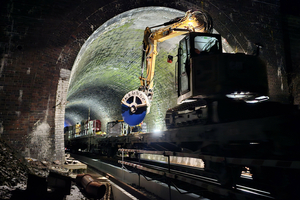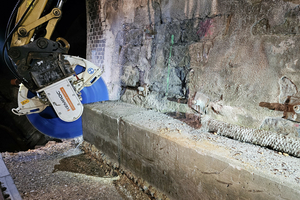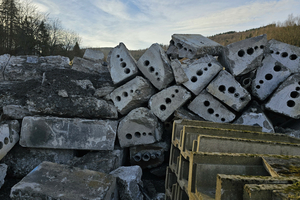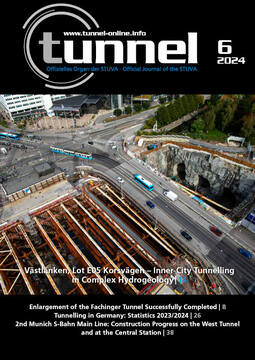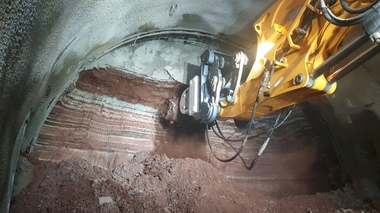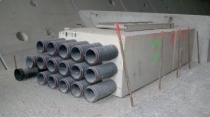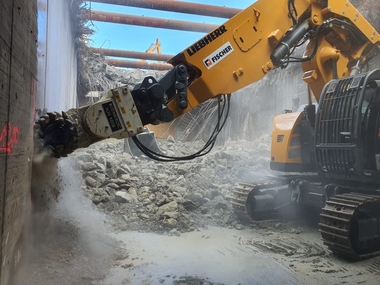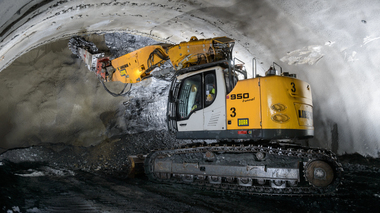Cross-Section Enlargement: Cable Ducts in the Elleringhauser Tunnel Dismantled With Diamond Saw
The Elleringhausen railway tunnel, which is more than 150 years old, is being extensively renovated. In order to install a new inner shell, concrete cable ducts had to be removed at the base of the tunnel wall. The specialists from ARGE EET (Erneuerung Elleringhauser Tunnel) chose an 8-tonne compact excavator and a Kemroc KDS diamond saw to cut the concrete structures into manageable pieces.
The Upper Ruhr Valley Railway, which connects Aachen and Kassel, runs through the almost 1400 m long Elleringhauser Tunnel railway tunnel near Olsberg and Brilon in North Rhine-Westphalia, Germany. The tunnel was built between 1868 and 1872 with a single tube and two tracks. The structure – a classic horseshoe-shaped brickwork – needs to be renewed after almost 150 years of use. The three contractors, Max Bögl Stiftung & Co. KG, Marti GmbH Deutschland and Marti Tunnel AG, have joined forces in the EET consortium.
The renovation work is mainly being carried out using the so-called tunnel-in-tunnel method, which avoids a prolonged full closure. This method involves an enlargement of the tunnel cross-section and the installation of a new precast inner shell. To create the necessary space for this partial step, the existing concrete cable ducts for signalling and lighting technology first had to be removed on both sides of the tunnel floor.
Compact Excavator With Diamond Saw
Dipl.-Ing. Thomas Töpfer, mechanical engineer from the consortium partner Max Bögl, explains the choice of the most suitable technology: “The use of an excavator with concrete shears or pulveriser was out of the question due to the lack of space in this tunnel with its narrow clearance profile. In addition, the renovation work is taking place during railway operations and only at night between 10 pm and 5 am. Therefore, a conventional method of core drilling and diamond cutting or wire sawing would not have been practicable, as the machine technology used would have had to be set up and
dismantled manually again and again.” For this reason, the consortium members opted for an unusual solution in tunnelling – a rented mini excavator with a KDS series diamond saw from the manufacturer Kemroc.
Cut, Break Loose, Remove
Diamond saws from the KDS series have been designed for cutting a wide variety of materials such as natural stone, granite, reinforced concrete, concrete, asphalt, plastics, wood, foils and aluminium. Mounted on crawler or mobile excavators and coupled with the on-board hydraulics, they deliver high performance in many industrial sectors with very little strain on the carrier, driver and environment. High speeds and a harmonised selection of diamond cutting wheels give the machines a wide range of applications and a high level of efficiency.
The combination of an 8-tonne compact excavator with a Kemroc KDS 30 diamond saw (80 kW rated power) proved to be practical for the Elleringhaus tunnel conversion project: On the one hand, the carrier machine with its compact geometry can move safely in the tunnel cross-section. Secondly, the diamond saw has a cutting wheel with a sufficiently large diameter to cut completely through the concrete trough (height x depth = 60 x 40 cm).
The work process is carried out like this: The mini excavator is moved around the tunnel on a platform trailer. At intervals of around 150 cm, the machine is positioned transversely in front of the cable duct at the foot of the tunnel walls. The machine operator then cuts through the concrete trough from top to bottom, switches to the hydraulic hammer and breaks free the cut concrete section with three or four blows. The operator then switches to the sorting grab and loads the concrete part for removal from the tunnel.
The cutting work took just under three weeks in January 2024 – significantly shorter than initially planned. Thomas Töpfer from JV partner Max Bögl sees his choice of machine confirmed: “We are already familiar with Kemroc‘s milling technology and range of models from previous projects, for example in tunnelling and asphalt road construction. It‘s good to know that the manufacturer‘s range also includes machines that are rather unusual in tunnelling, but which can be exactly the right solution in certain cases like this one.”
Completion Planned by 2029
The main construction work, including tunnelling for the enlargement of the cross-section, construction of the outer shell as well as the construction of a rescue tunnel and connecting structure, is scheduled to continue until 2028. According to the current planning, the tunnel is scheduled to be fully reopened in spring 2029.

